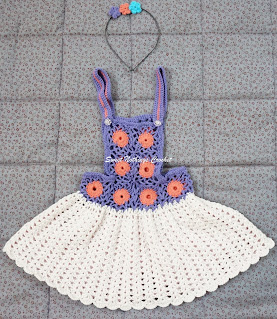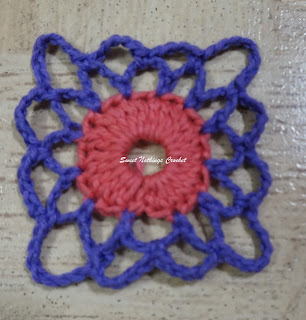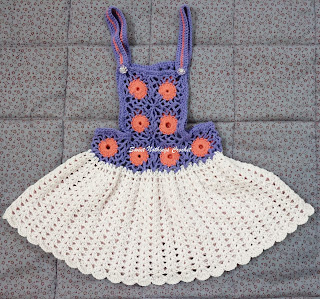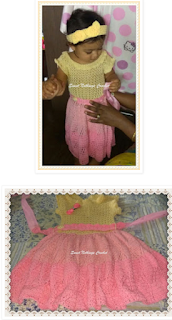I made a crochet pinafore baby dress a few days back and
I received an order for another similar dress.
You know how I love to create a slight difference each time, so let’s
work on this is 2nd cute crochet baby dress project together. For today's project I've used 3 colors of unbranded knitting cotton yarn with a 3.5 mm crochet hook
You can work this pattern for any size, using
any yarn with a suitable hook.
Thank you for joining me.
In case you have just joined me, know that you can access all of my earlier creations by checking under ‘categories’ on the right hand side of this blog under “Labels”.
How labels work : All patterns under a similar label can be found together so when you click on the label for say "crochet baby dress pattern", all my baby dress patterns are available - so scroll down to the very bottom and click on "Older Posts" to move onto the next post in the series. Before you reach that you have several other ways to find my blogs including blog links at the bottom of this blog
For your convenience, follow me here or on Facebook, You Tube, Pinterest, Twitter or Instagram.
Oh, and may I add that the fastest way to find any of my blogs is via Pinterest and if you are looking for more children wear then come here
All my blogs can be printed. Find the print friendly (green) link on the right of this blog. You can also hit Control P (or Command P for Mac) on your keyboard, and the blog will go directly to the connected printer.
Remember that you only print if absolutely essential. Save paper – Save Our Earth.
The best way to find me is via Pinterest here and if you are looking for more children wear look here and be inspired by this pin here . Thanks for joining me once again as we work on and discover this new pattern together.
Do remember to add my blog URL when you make and show off your creation.
Just copy the link on the search bar above - that's the blog URL.
To purchase this or similar yarn online, click the highlighted links below to buy your yarns online via Amazon. While you will still pay the same, I may get paid by Amazon as well. This is a free blog - so do pay it forward for me. Cheers.
General yarn info : The yarn used today is not specific to this pattern.
You can use any yarn with a suitable hook to make this project to any size.
International yarns : Among the international yarns I have used in this thickness, I’d suggest Aunt Lydia Cotton 10, Aunt Lydia Bamboo-Viscose 10, DMC Petra, Sullivans knitting cotton (Australia), Milford Soft, Hilaza Rustica Eclat , Alize cotton yarn and Alize bamboo yarn , Lily Sugar n' Cream cotton yarn, Caron Simply Soft , Bernat Softee chunky.
Skill level :
Intermediate to Advanced.
Abbreviations used : (Using U.S terminology)
ch : chain ch-sp
: chain space
sp : space rep
: Repeat
fsc : Foundation single crochet
dc : Double crochet
Stitches used :
Foundation half double crochet (fhdc) : This is an easy way to start a row of hdc without the starting chain row.
Half Double Crochet : Hdc : yo, insert hk into st ; yo (3 lps on hk) ;
yo, draw through all 3 lps. One hdc made.
Chainless start for Half Double Crochet : I dislike the ch-2 start, and this is what I do to start my row of hdc. Check out the video at https://youtu.be/lWXpl1KdbZ8 Here is a sizing chart for general sizing here , here or here
Instructions : (Using U.S terminology)
Please note that I start all my rows with a ch 1, turning chain for ease.
Please check the top of this blog for easy video tutorials on all stitches used in today's pattern. For your convenience there video tutorials through the blog too
Please read through all my notes before you pick up your hook, so you know just where we're heading in our pattern.
In my patterns I work with the principle of stitch count and body measurement.
This means that you need to work the stitch count in pattern, till you get the measurement (length and/or width) that you need for your project.
Quick analysis of what we’re going to do here
today.
This is a top down
creation. Using
a cute set of motifs / (granny) squares, we will create the pinafore and belt
first. We will then work the skirt portion off the bottom of the belt.
I have used the motifs from a lovely pattern by Lena Fedatova, with her permission. For the skirt, I have used a simple set of growing “V” / shell sts.
As I work on this pattern, with my tweaks, I’ve written down my notes that I share with you.
When calculating your start measure for the
skirt, take both waist and hip measurements.
If the child’s waist and hips are the same size,
then you can take half the round measure.
If there is a difference, please take half the
round measure of the one that is more (or larger)
Always keep a
margin in mind for the stretch of yarn as well as the looseness of your work
(tension)
Remember to keep in mind that
the belt bit (and how wide you want it) will add to the length of your skirt.
PART 1 : Pinafore & belt
This project can be made in one
colour but, I am opting to use two colours.
I will not be indicating when
to change colours, as I’d love you to work in your creativity here. Cheers.
The pinafore and belt portion
are made with cute little squares that I have taken from the lovely Lena
Fedatova’s Green Apple Bolero pattern.
I have Lena’s permission to use
her pattern to create this pinafore dress.
Please go HERE for the pattern of the individual (granny) square.
Oh and once you are done with this
dress, you could use Lena’s bolero pattern to make a cute little jacket for
this dress.. how cool is that, right?
Here is how I suggest you place your
motifs for making the pinafore and belt.
Please note that the number of motifs you use may differ depending on
the size of dress you make.
The diagram below is not to scale - it is only representative of how to place the motifs , work the straps and work the skirt portion.
So how do you decide how many
(granny) square motifs you need?
a) Decide on the width
and length that you want for your pinafore
b) Keep your half round
waist measurement in hand
c) Make one motif /
granny square and see what measurement you get.
d) Remember that if you
are making this for an older child who has a difference in waist and hip
measures, you will not
attach the last set of squares. You will then add in a button so that there
is an automatic ease in the belt.
e) Remember also that
we could thread in a belt or satin ribbon into the centres of the granny squares. This will look neat and also cinch the waist
up in case you have worked just a little more than needed for the waist and /
or find it is too loose.
OK, so you have taken your
measurements.
Now armed with all these
numbers, let’s put them to work for us.
Let’s say your motif / granny square
is 2.5” square and you are making this for a 1 yr old / Waist : 20”. This means, half round waist measure = 10”
(front + back = 10” + 10” = 20”)
So 2.5” per granny square = 4 squares
across = 10” (2.5” x 4 = 10”).
Therefore you make 4 squares each for
the front and back.
That solves your belt sizing.
Similarly you can calculate the width
and height of the pinafore bit.
Easy enough, right?
Remember : Belt adds to the length of your skirt.
OK.. go off to the link for the
Green apple bolero and make the belt and pinafore.
PART 2 : Straps
Once you have completed the
pinafore portion and the belt, we will finish this portion and the straps
before we start on the skirt portion of our dress.
Before we start, let us run a
round of sc all around the pinafore bit and top of the belt.
Re-attach your yarn at any sc ;
sc in the same sc ;
*2 sc in the next ch-sp ; sc in
the next sc* ;
rep *to* all around and join
with a sl-st to the 1st st.
Run a round of sc all around
once more, just to strengthen and neaten up the edge. Ensure that you work 2 or 3 sc in each corner
sc (of pinafore) for ease.
We now need to make our straps.
For the strap :
a) First decide how wide you want your strap. Say 6 sts.
Work hdc / dc in each st for 6 sts and Turn.
b) Continue working only on these 6 sts back and forth till you
have the strap length needed.
c) Your strap will either join up at the pinafore flap at the
back or the waist band at the back.
d) Add buttons and button holes (if desired) at the end of your
strap.
e) You can also add a press-button for convenience.
f) Check this blog here and scroll through to the end for a novel idea on creating
your own little designer matching button
Fasten off and weave in
ends.
Part 3 : Skirt portion
You have your pinafore and belt done, and you
will now be working the skirt off the ch-5 sps of the belt.
For the skirt portion, we will be working in
rounds. You will join with a sl-st at
the end of each round.
Here’s where the fun begins and all of this
fun is just for the 1st start round!
You get to decide just how frilly you
want your dress.
a) You
can work the “V”-st in every ch-5 sp ;
b) OR
you can decide to use ch-5 sps and the sc in between ;)
c) The
frilliness of your dress will depend on how close (or far apart) you keep your “V”-sts.
d) We
start with a slender “V”-st but it will build up so your dress will flare out.
e) How
do you know approximately how much flare you want or are going to get? Well, you will get an idea after you complete
Round 2. Place your work down and
measure then – and if needed go back to change the distance between your Round
1 “V”-sts. You should have this just a little more than the round waist measure
– and as we are going to work larger “V”-sts as the pattern grows, your flare
will grow too. Got it?
For the first round below, I am not going to
indicate how many ch-5 sps you need to skip. I will just indicate that you need to work in
a ch-5 sp and you will decide how many you are skipping.
Let the fun begin!
Our “V”-st will be (dc ; ch 1, dc) all in the
same ch-5 sp.
Attach your yarn in the 1st ch-5 sp.
Double Crochet : dc : yo, insert hk into st ; yo (3 lps on hk);
[yo, draw through 2 lps] twice. One dc made.
Check out the video at https://youtu.be/xdnjB27zpYo
Chainless start for Double Crochet : I dislike the ch-2 / ch – 3 start, and this is what I do to start my row of dc.
Check out the video at https://youtu.be/wskv3iTjRx0
Round 1 : “V”-st in the 1st ch-5 sp and in each ch-5 sp
all around ;
Join with a sl-st to the 1st
st.
From this round on, we will work our “V”-st in the ch-sp of the earlier “V”-st.
Round 2 : sl-st into the 1st “V”-st ; “V”-st in the same 1st
“V”-st ;
*ch 1, “V”-st in the next “V”-st*
;
rep *to* all around ;
ch 1, and join with a sl-st to
the 1st st.
Our “V”-st 1 now
will be (2 dc ; ch 1, 2 dc) all in the same “V”-st.
Rounds 3 - 6 : sl-st into the 1st “V”-st ; “V”-st
1 in the same 1st
“V”-st ;
*“V”-st 1 in the next “V”-st* ;
rep *to* all around ;
Join with a sl-st to the 1st
st.
Please put your work down and
check the flare of your dress.
IF you
think it is alright, and going nicely, continue without any change till
you get the length needed for your dress.
IF you think you want a
slightly better flare, work in the next increase now.
Round 7 : sl-st into the 1st “V”-st ; “V”-st
1 in the same 1st
“V”-st ;
*ch 1, “V”-st 1 in the next “V”-st* ;
rep *to* all around ;
ch 1, and join with a sl-st to
the 1st st.
Continue with Round 7 till you
get to the length needed for your dress.
For our last round we will work
6 dc in each “V”-st ch-1 sp and 1 sc in the “space” between two “V’-sts. There is no real stitch in the space, we just
place the sc there, and it ‘holds’ our 6 dc down, creating a nice shell stitch
border.
Last Round : sl-st into the 1st “V”-st ; 6
dc in the same 1st “V”-st ;
*sc in the space between the
next 2 “V”-sts
; 6 dc in the the next “V”-st* ;
rep *to* all around ;
sc in the last sp, and join
with a sl-st to the 1st st.
Fasten off and weave in ends.
For the flowal headband, please go HERE
And that’s done.. yet another
project brilliantly executed !
If you're visiting me here for the first time, and have liked the experience, do add me to your mailing list (for your convenience) , and all my future free patterns will come straight to your mail box.
I’d appreciate if you could credit my blog (and link the original pattern link) when you make your own creation. Thanks.
Have a great day and see you soon.
I have a few dresses already made, and just in case you want a dekho at those free patterns … here you go
and here are a few skirt patterns that you can use your belt for..
Here are some of my tops
Here are some of my bolero / jacket / vest creations. Have fun with these free patterns too
Here is a list of my earlier miscellaneous home use projects. Enjoy















































No comments:
Post a Comment
Thanks for taking the time to stop by. Do tell me what you think. Cheers